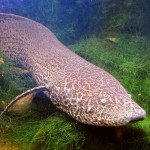Fins as early legs
“Walking” fish may help scientists understand how ancient animals learned to move on land

You may not be familiar with the word tetrapod, but you know one when you see it. All tetrapods are vertebrates — animals with backbones — and most move on land. They also have four limbs — or their ancestors did, as in the case of snakes and whales, for example. Reptiles, birds and amphibians all count as tetrapods. So do mammals. That means you’re a tetrapod.
By studying fossils, scientists know that tetrapods haven’t always roamed Earth. They evolved from animals called lobe-finned fishes, which are named for their thick, strong fins. Over many generations, the fishes grew features that helped them move onto land. These features, which included longer limbs and digits, began appearing in the animals about 400 million years ago. (Digits are structures like fingers and toes at the end of a limb.)
So fossils provide evidence that tetrapods evolved from lobe-finned fishes. But they don’t show how the animals learned to walk (or hop, or scuttle or fly). Now, a team of biologists has found evidence that animals were preparing to walk while still living underwater. In a new study, the researchers suggest that lobe-finned fishes pushed themselves around with fleshy fins. And they did this long before they moved onto land and grew longer limbs and digits.
In the new work, the scientists didn’t scrutinize the fossil record. Instead, they pointed video cameras at living lobe-finned fishes called African lungfish. They watched as the animals scooted around the floor of an aquarium. Because lungfish are so closely related to tetrapods, scientists study the creatures to learn more about how ancient aquatic animals made a transition to living on land.
“The cool thing about the lungfish is that it’s walking underwater,” biologist Heather King told Science News. She works at the University of Chicago, in Illinois. “And if lots of tetrapods were also doing this it could mean that the first step in the evolution of vertebrate walking took place underwater.”
Using cameras aimed at different angles, she and her colleagues recorded video footage of individual lungfish. The cameras showed that the animals push themselves along using alternating fins. This is just as animals use alternate legs to walk or crawl.
Neil Shubin, another University of Chicago biologist, also worked on the study. He said the recordings clearly show the animals’ motions. “If you asked me to tell you what those fins do just by looking at them, I’d give you a thousand functions, and walking wouldn’t be one of them,” he told Science News. “But that’s what they do.”
POWER WORDS (adapted from the New Oxford American Dictionary)
evolve To develop gradually over successive generations.
tetrapod A four-limbed animal, including amphibians, reptiles, birds and mammals.
digit A structure, like a finger or toe, at the end of the limbs of many vertebrates.
lobe A rounded and somewhat flat projection.







